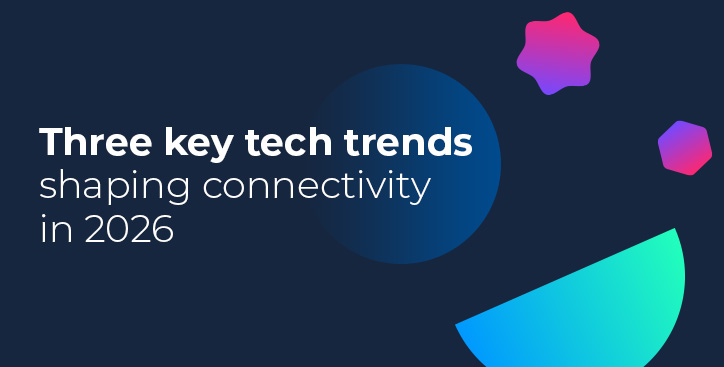Why you need to prepare your network for the rise of generative AI
By Lily Bennett|16 July, 2024

The evolution of generative AI is beginning to rapidly transform the way that we work and communicate. This is only set to increase as generative AI excels in providing business value by driving innovation and making intelligent decisions at unprecedented speeds. However, to fully harness its potential, organisations must ensure that they deploy this revolutionary technology safely, securely and responsibly with the right network connectivity. But how many organisations are prepared to manage this emerging technology?
The impact of generative AI on networks
In January 2024, Console Connect conducted a global survey with 1,000 Chief Technical Officers (CTOs) and senior IT Leaders from various sectors, including technology, financial services, communications, manufacturing, and retail. The survey aimed to understand their thoughts on the opportunities and challenges generative AI has created for their networks.
The findings revealed that a staggering 69% of senior IT leaders do not believe their current network infrastructure has the capacity to embrace generative AI to its full potential. Yet, 88% said they plan to deploy generative AI in the near future. This indicates that the value of AI is understood and there is pressure to adopt it.
Organisations must understand that generative AI demands substantial computing power and data processing capabilities, necessitating fast and flexible network solutions. Without the right network infrastructure, businesses risk missing out on the technology's full potential.
Industries leading the charge
Several industries are leading the charge in upgrading their network management systems to accommodate generative AI.
Banking: Generative AI has revolutionised customer service in banking by creating intelligent virtual assistants that provide personalised interactions and automate tasks. For example, NatWest collaborates with Amazon Web Services to enhance its AI capabilities.
Retail: The retail sector has rapidly adopted generative AI to strengthen customer relationships. AI platforms analyse customer data in real-time to offer personalised recommendations. Ikea’s Kreativ app, for instance, uses generative AI to create virtual replicas of customers' homes, showcasing products for each room.
Healthcare: In medical research, generative AI accelerates clinical drug trials by simulating predictive outcomes, reducing time and costs. Insilico Medicine, a Hong Kong biotechnology company, uses Pharma.AI to identify promising targets for diseases like cancer.
Finance: Finance and fintech companies use generative AI for predictive trading algorithms that process vast amounts of financial data to forecast investment decisions. Bridgewater Associates, the world’s largest hedge fund, has an AI Lab dedicated to exploring advanced AI applications.
Examining your existing network
For all the benefits that generative AI offers, they will remain beyond reach if your current network infrastructure cannot store, process, and retrieve the massive datasets which this burgeoning technology thrives on.
Before selecting a generative AI tool or platform, businesses must conduct a thorough analysis of their current network to determine whether it can ensure seamless and augmented AI workflows. Key considerations include edge computing capabilities, network security, and the ability to monitor AI interactions with the network.
Ensuring network security: Network security is a major concern for businesses adopting generative AI. The survey found that 71% of respondents feared increased cyberattack risks, with concerns even higher in regions like Australia (90%). Cybersecurity risks and a lack of IT skills or expertise were also significant barriers to immediate adoption.
Hybrid and multi-cloud environments: As businesses increasingly operate in hybrid or multi-cloud environments, the integrity of data transferred across public and private clouds becomes critical. Secure, dedicated connections between data sources and generative AI models are essential to protect data integrity and prevent cyber threats.
Scalability and flexibility: The rapid progression of generative AI technology necessitates agile and scalable networks. Businesses must ensure their networks can support future AI advancements and growth while defending against evolving cyber threats.
The human factor: Effective deployment of generative AI requires training IT teams to harness its potential and maintain dynamic network capabilities. Regular upskilling is crucial to ensure that network infrastructure keeps pace with AI advancements. However, the survey findings indicate that this training is not happening adequately with the second highest concern (39%) among survey respondents being a lack of skills/expertise with the IT team to support it. This highlights the need for ongoing education and skill development.
Ultimately, only with the right network infrastructure in place can businesses fully leverage the transformative power of generative AI, driving innovation and achieving new levels of operational efficiency.
How NaaS can help
The rise of generative AI and increase of cloud workloads means that businesses need to reassess their network models for handling larger volumes of mission-critical data. Network-as-a-Service (NaaS) platforms like Console Connect ensure organisations have the network capabilities needed to support AI technology. By adopting a NaaS model and using a private network connection, businesses have more flexibility in managing their connectivity to match the unpredictable patterns of AI, data is protected against cybersecurity threats associated with using the public internet, and egress charges and provisioning times are significantly reduced.
For more insight on understanding the connectivity requirements of generative AI, how to deploy AI successfully and what to expect in the future, download your free copy of the report below.



.jpg)





.jpg)